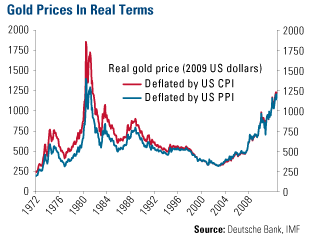It’s no secret that we’re long-term bullish on commodities.
Our boiled-down viewpoint: there will likely be short-term volatility in the sector, but we believe the enduring strength of the global growth story being led by China and other key emerging markets will be a powerful demand driver in the years ahead.
Some of the research crossing our desks this week seems to line up with our thesis, and it also offers some perspective in the shorter term.
Goldman Sachs forecasts crude oil rising to $85 to $95 per barrel before the end of 2010 based on rising demand from emerging markets and limited supply response. It also sees gold at $1,300 per troy ounce in the next six months, and potentially even higher if the Fed comes out with another round of quantitative easing (QE). Oil and copper could also benefit in a QE scenario, Goldman says – more money created, more spending on key commodities.
 Deutsche Bank is less enthusiastic about oil than Goldman, but still sees upside for commodities. It likes copper and nickel (used in stainless steel) on fundamentals and also for investment appeal, and it believes gold will be driven up by central bank buying. “Gold prices would need to move above $1,450 to be considered extreme in real terms,” DB analysts wrote.
Deutsche Bank is less enthusiastic about oil than Goldman, but still sees upside for commodities. It likes copper and nickel (used in stainless steel) on fundamentals and also for investment appeal, and it believes gold will be driven up by central bank buying. “Gold prices would need to move above $1,450 to be considered extreme in real terms,” DB analysts wrote.
BCA Research writes that energy stocks are attractive as an oversold sector, and that industrial metals are appealing over the medium term. While BCA likes copper, it likes aluminum even more both as a substitute metal for steel and due to continued strong demand from China, the world’s leading incremental consumer. Its analysts also suggest taking profits in gold during price spikes.
Gold has been on a good run, making new all-time nominal highs this week. September is historically the best month for gold, given the many jewelry-giving holidays around the world between now and February. We see rising incomes in the emerging-market nations with an affinity for gold as an important driver now and in years to come.